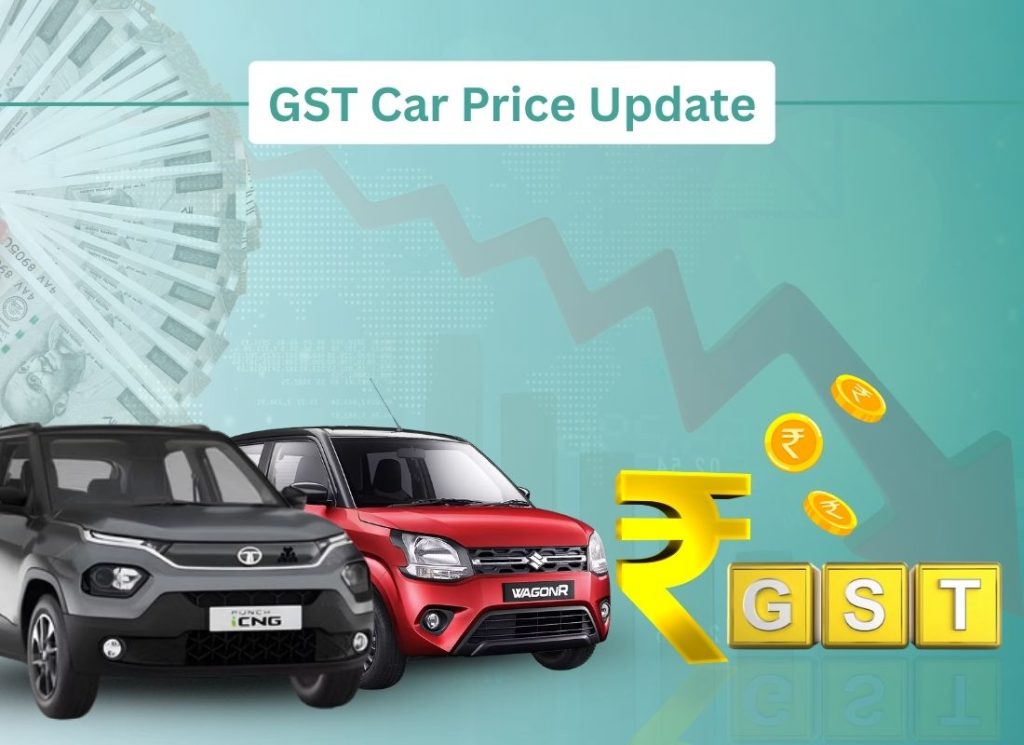The Indian automobile industry has just witnessed one of the most significant price corrections in recent memory. With the government rolling out fresh GST reforms, new car prices across multiple segments — from budget hatchbacks to premium SUVs — have dropped sharply. The move, aimed at boosting demand and improving affordability, is already sending ripples across the market.
For buyers, this reform means more value for money. A hatchback that seemed just out of budget last month might now be comfortably affordable. For families eyeing an SUV, the price gap between mid-size and premium offerings has narrowed. Automakers like Hyundai, Toyota, Mahindra, Tata, Skoda, Renault, and Maruti Suzuki have already announced revised prices, with benefits ranging anywhere from ₹50,000 to over ₹5.8 lakh depending on the model.
But the story does not end at the showroom. The impact of these GST reforms is set to spill into the used car market, where sellers will have to recalibrate expectations. Pre-owned cars, especially in the small car segment (under 4 meters), form the backbone of India’s second-hand market. With new cars suddenly becoming cheaper, buyers will naturally push back on inflated used-car prices.
This presents both an opportunity and a challenge. Buyers now have more leverage in negotiations, while sellers may find themselves trimming asking prices to stay competitive. The result is a dynamic reset across the entire ecosystem — one that could make this festive season the best time in years to buy a car, whether new or used.
Maruti Suzuki: Relief on India’s Best-Sellers
Maruti Suzuki, the country’s largest carmaker, sees GST benefits flowing across its most popular cars. From budget hatchbacks like the Alto and Wagon-R to mainstream favorites like the Swift, Dzire, and Brezza, Maruti’s reductions make it difficult for competitors to match. Notably, the Swift sees a benefit of over ₹1.6 lakh, one of the largest among small cars.
| Model | Full GST Benefit |
|---|---|
| Alto K10 | ₹1,24,106 |
| S-Presso | ₹1,18,248 |
| Wagon-R | ₹1,41,452 |
| Celerio | ₹1,35,261 |
| Eeco | ₹1,06,304 |
| Swift | ₹1,60,519 |
| Ertiga | ₹67,252 |
| Dzire | ₹1,22,525 |
| Brezza | ₹99,859 |
Hyundai: Mid-Segment Leader Now More Accessible
Hyundai has been one of the strongest players in the compact and mid-size car market. With models like the i20, Venue, and Creta being top-sellers, the GST cuts make these cars even more attractive. Notably, the Tucson gets the steepest price benefit of over ₹2.4 lakh, bringing down the premium SUV’s effective cost.
| Model | Full GST Benefit |
|---|---|
| Nios | ₹73,808 |
| Aura | ₹78,465 |
| Exter | ₹89,209 |
| i20 | ₹98,053 |
| i20 N Line | ₹1,08,116 |
| Venue | ₹1,23,659 |
| Venue N Line | ₹1,19,390 |
| Verna | ₹60,640 |
| Creta | ₹72,145 |
| Creta N Line | ₹71,762 |
| Alcazar | ₹75,376 |
| Tucson | ₹2,40,303 |
Toyota: Big Relief on Premium Models
Toyota’s portfolio has traditionally been positioned on the premium side, and the GST reduction makes its high-value products significantly cheaper. While entry models like Rumion and Glanza see moderate benefits, the biggest winners are the Fortuner and Vellfire, with price drops crossing the ₹3 lakh mark. This makes Toyota’s aspirational lineup more accessible to a wider set of buyers.
| Model | Full GST Benefit |
|---|---|
| Rumion | Up to ₹48,700 |
| Hyryder | Up to ₹65,400 |
| Glanza | Up to ₹85,300 |
| Camry | Up to ₹1,01,800 |
| Taisor | Up to ₹1,11,100 |
| Hycross | Up to ₹1,15,800 |
| Crysta | Up to ₹1,80,600 |
| Hilux | Up to ₹2,52,700 |
| Vellfire | Up to ₹2,78,000 |
| Fortuner Legender | Up to ₹3,34,000 |
| Fortuner Normal Model | Up to ₹3,49,000 |
Mahindra: SUVs Made More Affordable
Mahindra’s rugged SUV lineup has seen strong demand in both rural and urban India. The GST cut makes models like the XUV3XO and Thar even more appealing. Interestingly, the benefits are not uniform, with larger SUVs like the Scorpio-N and XUV700 getting relief of up to ₹1.45 lakh. This price correction could further fuel the demand for Mahindra’s already popular SUVs.
| Model | Old GST + Cess | New GST | Full GST Benefit |
|---|---|---|---|
| Bolero/Neo | 31% | 18% | ₹1.27 Lakh |
| XUV3XO (Petrol) | 29% | 18% | ₹1.40 Lakh |
| XUV3XO (Diesel) | 31% | 18% | ₹1.56 Lakh |
| Thar 2WD (Diesel) | 31% | 18% | ₹1.35 Lakh |
| Thar 4WD (Diesel) | 48% | 40% | ₹1.01 Lakh |
| Scorpio Classic | 48% | 40% | ₹1.01 Lakh |
| Scorpio-N | 48% | 40% | ₹1.45 Lakh |
| Thar Roxx | 48% | 40% | ₹1.33 Lakh |
| XUV700 | 48% | 40% | ₹1.43 Lakh |
Tata Motors: Popular Hatchbacks and SUVs See Gains
Tata’s position in the hatchback and compact SUV segment has strengthened in recent years. Models like the Nexon, Altroz, and Punch are already among the top-sellers, and with GST benefits now reaching up to ₹1.55 lakh, the company is poised to attract even more first-time buyers. Larger SUVs like the Harrier and Safari also see benefits of over ₹1.4 lakh.
| Model | Full GST Benefit |
|---|---|
| Tiago | Up to ₹75,000 |
| Tigor | Up to ₹80,000 |
| Altroz | Up to ₹1,10,000 |
| Punch | Up to ₹85,000 |
| Nexon | Up to ₹1,55,000 |
| Curvv | Up to ₹65,000 |
| Harrier | Up to ₹1,40,000 |
| Safari | Up to ₹1,45,000 |
Skoda: Deep Discounts on Top of GST
Skoda has taken a dual approach by offering GST-linked cuts as well as limited-period discounts. This makes its models among the most attractive in the premium mid-size category. The Kodiaq, in particular, becomes cheaper by a staggering ₹5.8 lakh when both benefits are combined.
| Model | GST Benefit | Discount (Till 21st Sep) | Total Offer |
|---|---|---|---|
| Kushaq | ₹66,000 | ₹2.5 Lakh | ₹3.16 Lakh |
| Slavia | ₹63,000 | ₹1.2 Lakh | ₹1.83 Lakh |
| Kodiaq | ₹3,30,000 | ₹2.5 Lakh | ₹5.8 Lakh |
Renault: Focus on Affordable Cars
Renault, which has carved a niche in the budget car segment, has extended GST benefits on its compact offerings. The Kwid, Triber, and Kiger, already positioned as value-for-money cars, now come at an even sharper price point, making them competitive against Maruti’s small car lineup.
| Model | Full GST Benefit |
|---|---|
| Triber | ₹53,695 – ₹80,195 |
| Kiger | ₹53,695 – ₹96,395 |
| Kwid | ₹40,095 – ₹54,995 |
Used Car Market: Adjustments Ahead
With new cars becoming cheaper, used car prices will inevitably come under pressure. Buyers will expect older models to follow suit, especially in the small car segment where the GST cuts are most visible. We have calculated the potential correction for 3-year-old and 5-year-old cars, applying a 7–10% reduction to reflect the post-GST environment.
Maruti Suzuki (Used Cars)
Maruti’s small cars dominate the used car market. With GST pushing new prices lower, sellers will need to realign quickly.
| Model | Avg 3-Year Price (Pre-GST) | New Adjusted (Post-GST) | Avg 5-Year Price (Pre-GST) | New Adjusted (Post-GST) |
|---|---|---|---|---|
| Swift | ₹6.5 L | ₹5.9–6.0 L | ₹5.2 L | ₹4.7–4.8 L |
| Wagon R | ₹5.0 L | ₹4.5–4.6 L | ₹3.8 L | ₹3.4–3.5 L |
| Alto | ₹3.2 L | ₹2.9–3.0 L | ₹2.2 L | ₹2.0 L |
| Baleno | ₹7.0 L | ₹6.3–6.5 L | ₹5.5 L | ₹5.0–5.1 L |
Hyundai (Used Cars)
Hyundai’s i20 and Grand i10 are highly sought-after in the pre-owned segment. The GST-led shift makes these older cars slightly less valuable compared to brand-new purchases.
| Model | Avg 3-Year Price (Pre-GST) | New Adjusted (Post-GST) | Avg 5-Year Price (Pre-GST) | New Adjusted (Post-GST) |
|---|---|---|---|---|
| i20 | ₹7.5 L | ₹6.8–7.0 L | ₹5.8 L | ₹5.2–5.3 L |
| Grand i10 | ₹5.5 L | ₹5.0–5.1 L | ₹4.0 L | ₹3.6–3.7 L |
Tata Motors (Used Cars)
Tata’s hatchbacks and compact sedans also face corrections. For first-time buyers, this could be an excellent opportunity to pick up relatively new Tiagos, Tigors, and Altroz at bargain prices.
| Model | Avg 3-Year Price (Pre-GST) | New Adjusted (Post-GST) | Avg 5-Year Price (Pre-GST) | New Adjusted (Post-GST) |
|---|---|---|---|---|
| Tiago | ₹5.0 L | ₹4.5–4.6 L | ₹3.8 L | ₹3.4–3.5 L |
| Tigor | ₹5.5 L | ₹5.0–5.1 L | ₹4.2 L | ₹3.8–3.9 L |
| Altroz | ₹6.0 L | ₹5.4–5.6 L | ₹4.6 L | ₹4.1–4.2 L |
Conclusion
The GST reforms have rewritten the pricing story of India’s auto sector. For new car buyers, the timing could not be better, with nearly every brand slashing prices. For used car sellers, however, the challenge lies in adjusting to a new reality where buyers will not settle for outdated price tags.
This double impact of GST reform means one thing is clear: India is entering its most buyer-friendly car market phase in years.




